The innovative surfing tech making waves
- Published

Foil boards have a long carbon-fibre rod extending downwards from their underside to two underwater wings
With more than 35 million surfers around the world, the sport is big business. The industry is increasingly turning to technology for bigger, better and safer thrills.
Kiana Fores appears to be standing on a surfboard that's flying through the air almost 3ft (1m) above the waves.
Moving smoothly over the water off the coast of the Hawaiian island of Oahu, the former professional surfer is riding on a hydrofoil surfboard, also known as a foilboard.
These are surfboards that have a long carbon-fibre rod, or mast, extending downwards from their underside to two underwater wings.
When the speed and momentum of the sea is sufficient, the wings (also made from carbon fibre) are pushed through the water, lifting the surfboard and its rider up into the air.
In turn, many foilboards now have electric-powered propellers built into their masts, giving extra power so they be used when there are no waves. This means that the user can go surfing not just on flat seas, but even on lakes and rivers.
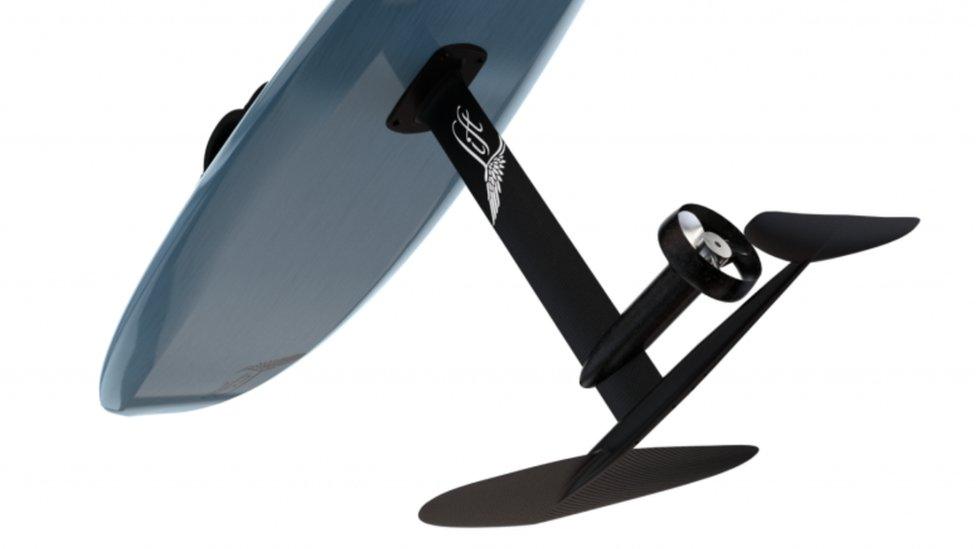
Many hydrofoil surfboards now have built in electric-powered propellers
"Part of what got me into foiling was the fact that there weren't many women doing it," says Ms Fores, aged 26. "Sometimes I catch the guys off guard, because they're like 'oh, there's a girl out here'.
"And then I think it trips them up that I can actually foil. So it's kind of exciting," she laughs.
While hydrofoil technology has existed in boating for more than a century, it wasn't until the early 2000s that it started to make its way into surfing. Electric-powered hydrofoil surfboards or 'efoils' then arrived in 2018 when Puerto Rican firm, Lift Hydrofoils released the first that was commercially available.
"Foiling is opening up the realm of what's surfable," says Nick Leason, the company's chief executive.
Our biggest efoil sales, by far, are coming from people who don't live by the ocean. They're like 50-year-old women who live near lakes." Mr Leason adds that the firm sold more than 4,000 products last year.
Artificial, inland surfing facilities have been around since the late 1960s, , external and to this day the aim for designers is bigger and better waves.
Australian firm, Surf Lakes, is preparing to debut what it says is the biggest thing to hit the sector, literally and metaphorically.
Still in the research and development stage, it has built a large test facility 20km (12 miles) inland from the Queensland coast. In the middle of a 3.6 hectare (nine-acre) man-made pool, a 1,400-ton, compressed air, steel pump goes up and down every six seconds. Powered by electricity, the pump creates 360-degree waves up to 8ft (2.4m) high, at a rate of 2,000 per hour.
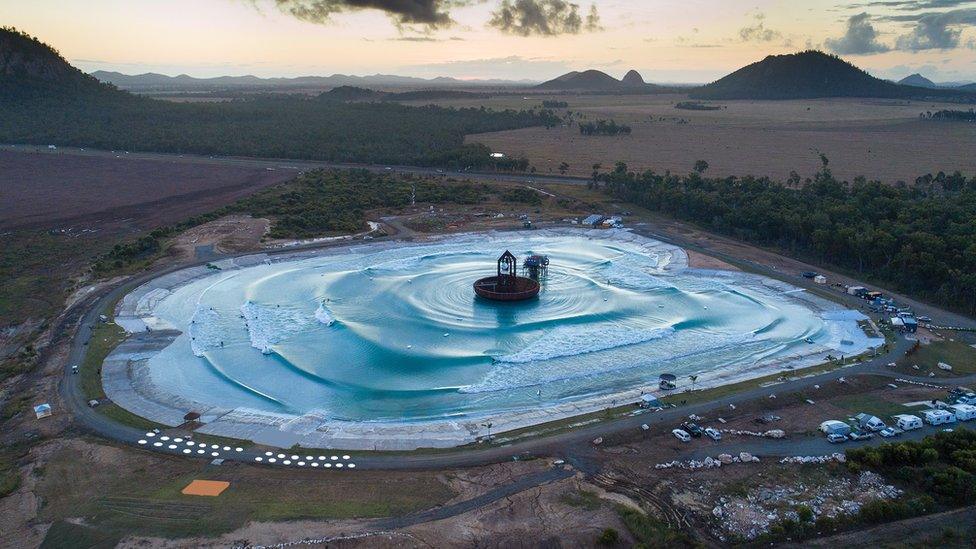
Surf Lakes aims to replicate its Australian test facility, pictured, at numerous locations around the world
"Imagine your best surfing session ever, on endless repeat," says Aaron Trevis, Surf Lakes' founder and chief executive.
He adds that there are five rings of waves in the pool at any moment, which vary in shape as they hit different parts of the lake. "So you can have a whole family with different surfing levels all surfing together at the same time."
Although the company has yet to open a facility to the public, it says it now has 20 projects in development across Australia, Asia, Europe and the US. Its biggest sites will allow 200 people to surf at the same time.
"The real market is the 99% of people in the world who have never surfed," says Mr Trevis. "In the next 10 years surfing could be 10 times the size the industry it is now."
He adds that Surf Lakes' system could theoretically make 15ft waves for professional surfing competitions.
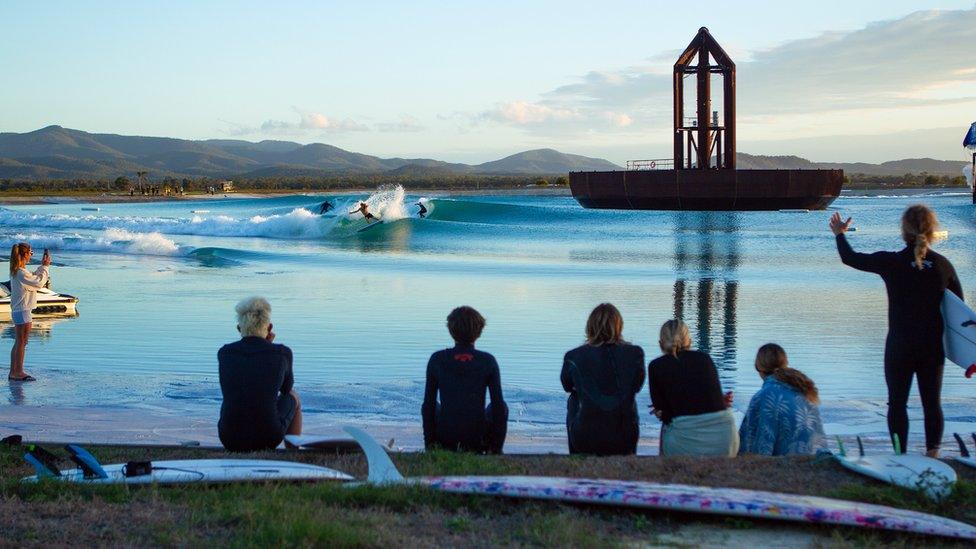
Surf Lakes says its facilities can create 2,000 waves per hour
Back out in the ocean, Maya Reis Gabeira from Brazil, holds the record for the highest wave successfully surfed by a woman. This was back in February 2020 when she conquered one 22.4m (73ft) high in Nazaré, Portugal.
"There's so much improvement with the help of technology," says the 34-year-old. "Like measuring the height of waves scientifically, in real time, for world record prospects.
"And communication is also now becoming much more sophisticated between people in the water [on jet skis] and on the cliffs," she adds, in regard to the crews on standby to rescue professional surfers that get into difficulties.
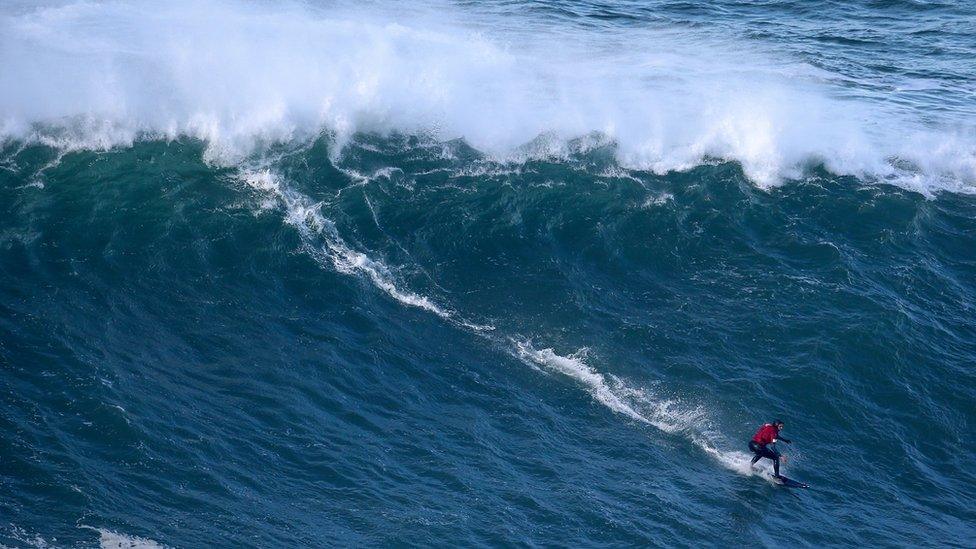
Maya Reis Gabeira, bottom right, surfing a very large wave
For surfers with environmental concerns, the fact that the majority of surfboards are still made from polyurethane, a type of plastic, is problematic.
A small start-up French company called Wyye, says one of the solutions is 3D-printing surfboards using bio-plastics which are made from corn starch.


New Tech Economy is a series exploring how technological innovation is set to shape the new emerging economic landscape.

Founded two years ago by friends, Sylvain Fleury and Leo Bouffier, Wyye now has eight employees, and four 3D printers running day and night at its base near Biarritz in south west France. The firm makes the boards according to each surfer's size, weight and requirements, and ships them across Europe.
In the future it wants to set up other manufacturing facilities overseas, each near key surfing locations.
"The goal is to duplicate our micro-factory model and 3D-print boards near popular surf spots around the world," says Leo Kerhir, Wyve's head of international business development.
He adds that it currently takes an average of 20-50 hours to print a single board. "But 3D printing technology is improving super fast. Now it's a two-week process from order to delivery, which is the same as a regular custom surfboard. And I think we can reduce that very soon."

Leo Bouffier, left and Sylvain Fleury plan to set up production facilities near surfing hotspots around the world
While shark attacks around the world remain thankfully rare, with a global average of 72 a year, , external they do worry many surfers.
Nathan Garrison is one such person, after a childhood friend from his hometown Charleston, South Carolina, was attacked when he was a teenager. And then years later a neighbour of his in California was killed by a great white shark.
To help prevent attacks, Mr Garrison launched a product called Sharkbanz, back in 2014. It is a small device that a surfer can wear on his or her wrist or ankle.
It uses magnets to create an electromagnetic field of about 6ft that interferes with the electric field senses that a shark uses to hunt and navigate.
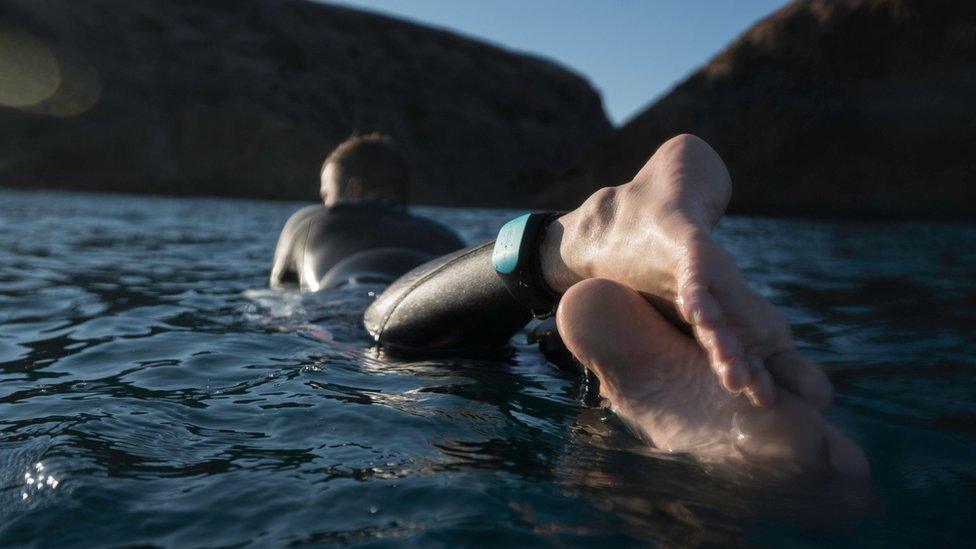
The Sharkbanz tag is bought by up to 30,000 surfers per year
"It's kind of like [the human equivalent of] looking at the sun with your eyes, or shining a bright light in someone's face," says Mr Garrison. "It's unpleasant for the shark and makes it want to turn away."
Although he now sells up to 30,000 Sharkbanz per year, a report by the Western Australia government found that the technology has a 65% success rate. That is less than two thirds, and in 2016 a surfer in Florida who was wearing the device required 44 stitches after a bite.
"Like any safety device, it's never going to be 100% effective," says Mr Garrison. "Sharks are wild animals. But this has been shown to at least reduce the risk. It tells a shark that you're there, and to look elsewhere for its meal."